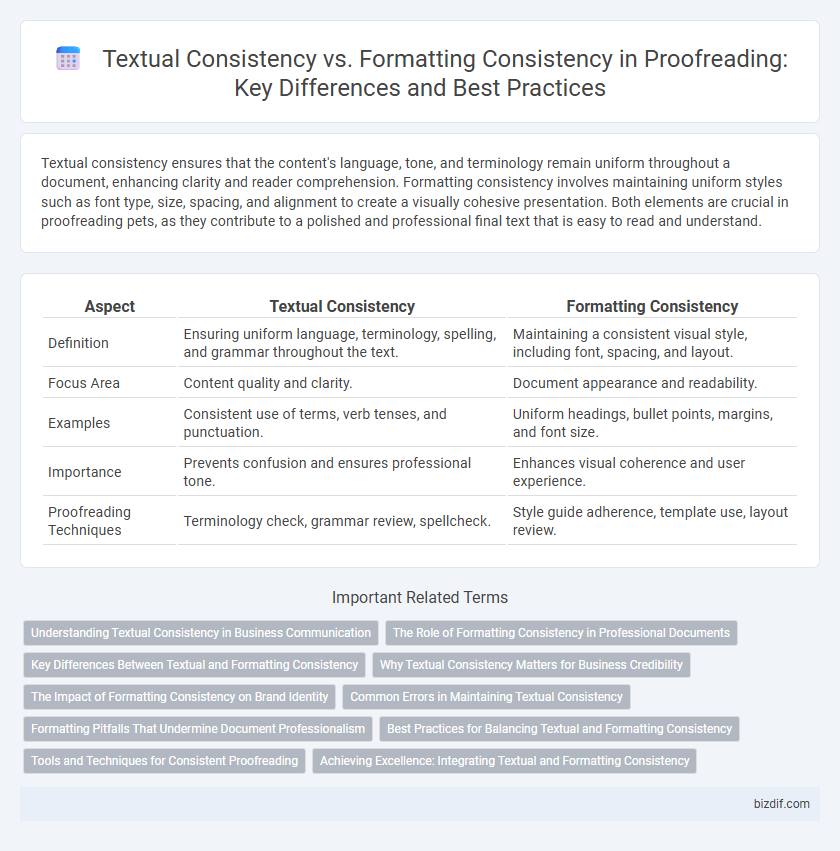Textual consistency ensures that the content's language, tone, and terminology remain uniform throughout a document, enhancing clarity and reader comprehension. Formatting consistency involves maintaining uniform styles such as font type, size, spacing, and alignment to create a visually cohesive presentation. Both elements are crucial in proofreading pets, as they contribute to a polished and professional final text that is easy to read and understand.
Table of Comparison
| Aspect | Textual Consistency | Formatting Consistency |
|---|---|---|
| Definition | Ensuring uniform language, terminology, spelling, and grammar throughout the text. | Maintaining a consistent visual style, including font, spacing, and layout. |
| Focus Area | Content quality and clarity. | Document appearance and readability. |
| Examples | Consistent use of terms, verb tenses, and punctuation. | Uniform headings, bullet points, margins, and font size. |
| Importance | Prevents confusion and ensures professional tone. | Enhances visual coherence and user experience. |
| Proofreading Techniques | Terminology check, grammar review, spellcheck. | Style guide adherence, template use, layout review. |
Understanding Textual Consistency in Business Communication
Understanding textual consistency in business communication ensures that terminology, tone, and style remain uniform throughout documents, fostering clarity and professionalism. Maintaining consistent language reduces misunderstandings and reinforces brand identity, which is vital for effective client and stakeholder engagement. This contrasts with formatting consistency, which primarily addresses visual elements such as font styles and alignment, rather than the coherence of the message itself.
The Role of Formatting Consistency in Professional Documents
Formatting consistency in professional documents enhances readability and establishes a cohesive visual structure that supports the textual content. Uniform font styles, spacing, and alignment minimize distractions and reinforce the document's credibility and professionalism. This consistency ensures that key information stands out, facilitating better comprehension and retention for the reader.
Key Differences Between Textual and Formatting Consistency
Textual consistency ensures uniformity in language elements such as spelling, grammar, and terminology usage throughout a document, enhancing clarity and reader comprehension. Formatting consistency involves maintaining a cohesive visual structure by standardizing font styles, sizes, spacing, and alignment, which supports professional presentation and ease of navigation. Key differences lie in textual consistency focusing on linguistic accuracy, while formatting consistency targets the document's visual coherence.
Why Textual Consistency Matters for Business Credibility
Textual consistency enhances business credibility by ensuring uniform language, tone, and style across all communications, which fosters trust and professionalism. Inconsistent terminology or messaging can confuse clients and diminish brand reliability, leading to potential loss of business. Maintaining textual consistency reinforces brand identity and supports clearer, more effective communication.
The Impact of Formatting Consistency on Brand Identity
Formatting consistency reinforces brand identity by ensuring all textual elements align visually, creating a cohesive and professional appearance. Uniform use of fonts, colors, headings, and spacing enhances brand recognition and trust among audiences. Inconsistent formatting can dilute brand messaging and reduce the perceived quality of communications.
Common Errors in Maintaining Textual Consistency
Common errors in maintaining textual consistency include inconsistent use of terminology, fluctuating tone or voice, and irregular application of tense throughout a document. Inconsistent spelling, such as alternating between American and British English, can also disrupt textual coherence. Failing to standardize abbreviations, acronyms, and capitalizations often results in confusion and diminishes the overall professional quality of the text.
Formatting Pitfalls That Undermine Document Professionalism
Formatting pitfalls such as inconsistent font styles, uneven spacing, and misaligned margins significantly undermine document professionalism by distracting readers and reducing readability. Maintaining uniform header sizes, bullet point styles, and paragraph indents ensures a polished and cohesive appearance throughout the text. Proper formatting consistency supports the overall credibility of the document, reinforcing clear communication and attention to detail.
Best Practices for Balancing Textual and Formatting Consistency
Achieving balance between textual and formatting consistency involves meticulously aligning language style, tone, and grammar while maintaining uniform font styles, spacing, and layout. Best practices include developing comprehensive style guides that cover both linguistic elements and visual presentation rules, ensuring cohesive and professional documents. Regularly using proofreading tools alongside manual reviews helps identify discrepancies in text and design, fostering seamless integration of content and format.
Tools and Techniques for Consistent Proofreading
Effective proofreading relies on both textual consistency and formatting consistency to ensure polished documents. Textual consistency tools like Grammarly and ProWritingAid focus on grammar, spelling, and style uniformity, while formatting consistency can be maintained using templates in Microsoft Word or Adobe InDesign, along with style guides such as APA or MLA. Techniques such as automated style checks, macros for repetitive formatting tasks, and custom style sheets streamline the proofreading workflow and minimize human error.
Achieving Excellence: Integrating Textual and Formatting Consistency
Achieving excellence in proofreading requires integrating textual consistency, which ensures uniform language use, terminology, and style, with formatting consistency that standardizes font, spacing, and layout across documents. Maintaining both aspects enhances readability, professionalism, and coherence, crucial for high-impact communication in academic, legal, and corporate texts. Advanced proofreading tools and style guides facilitate the synchronization of textual and formatting standards, reducing errors and improving overall document quality.
Textual consistency vs Formatting consistency Infographic

 bizdif.com
bizdif.com